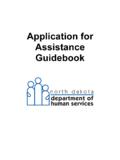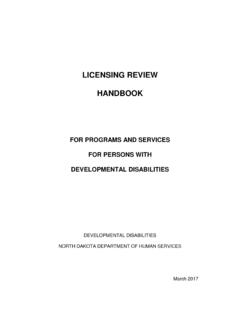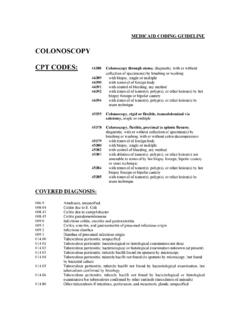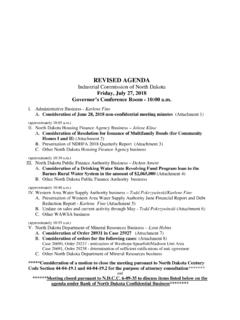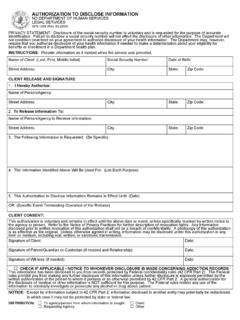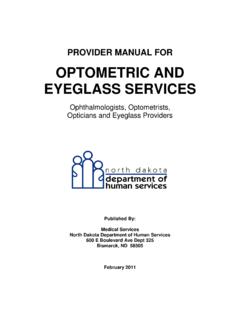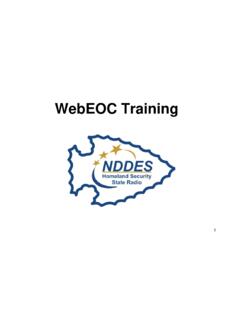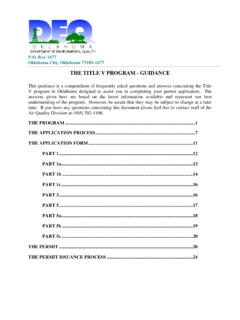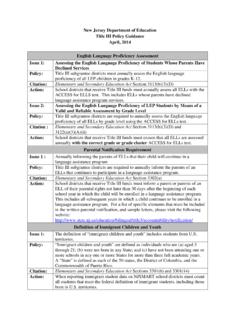Transcription of Guidance on Title III - North Dakota
1 Guidance on Title III English Language Learners in North Dakota Office of Indian/Multicultural Education (701) 328-1876 October 2016 Kirsten Baesler State Superintendent Department of Public Instruction 600 East Boulevard Avenue #201 Bismarck, ND 58505-0440 The Department of Public Instruction does not discriminate on the basis of race, color, religion, sex, national origin, disability, age, sex (wages) or genetics in its programs and activities. For inquiries regarding nondiscrimination policies, contact Stefanie Two Crow, Director of Federal Title programs , Department of Public Instruction, 600 East Boulevard Avenue, Dept. 201, Bismarck, ND 58505-0440, phone: (701) Purpose What are the purposes of Title III subgrants? (1) to help ensure that children who are limited English proficient, including immigrant children and youth, attain English proficiency, develop high levels of academic attainment in English, and meet the same challenging State academic content and student academic achievement standards as all children are expected to meet; (2) to assist all limited English proficient children, including immigrant children and youth, to achieve at high levels in the core academic subjects so that those children can meet the same challenging State academic content and student academic achievement standards as all children are expected to meet; (3) to develop high-quality language instruction educational programs designed to assist State educational agencies (SEA), local educational agencies (LEA), and schools in teaching limited English proficient children and serving immigrant children and youth.
2 (4) to assist State educational agencies and local educational agencies to develop and enhance their capacity to provide high-quality instructional programs designed to prepare limited English proficient children, including immigrant children and youth, to enter all-English instruction settings; (5) to assist State educational agencies, local educational agencies, and schools to build their capacity to establish, implement, and sustain language instruction educational programs and programs of English language development for limited English proficient children; (6) to promote parental and community participation in language instruction educational programs for the parents and communities of limited English proficient children; (7) to streamline language instruction educational programs into a program carried out through formula grants to State educational agencies and local educational agencies to help limited English proficient children, including immigrant children and youth, develop proficiency in English, while meeting challenging State academic content and student academic achievement standards; (8) to provide State educational agencies and local educational agencies with the flexibility to implement language instruction educational programs , based on scientifically based research on teaching limited English proficient children, that the agencies believe to be the most effective for teaching English.
3 Process How does a district apply for Title III funds? The NDDPI sends out an Intent to Apply Notice in the spring of each year to Local Education Agencies (LEAs) requesting their interest in applying for the Title III funds. The NDDPI requests interested LEAs to submit a Title III Letter of Intent. The minimum grant award of $10,000 must be reached by each applicant. This may include a single district applying independently or more than one district applying jointly as a consortium or cooperative (co-op). If a district is a member of a co-op or consortium, the district must also complete a Consortium/Co-op Form and submit both forms to their consortium/co-op fiscal agent. The consortium/co-op will submit all forms to the NDDPI. The NDDPI will only accept intents and agreements from the fiscal agent of the consortium/co-op. Requirements What specific requirements must be met for recipients of Title III funds? School districts must assure they will: Annually measure the English proficiency of EL students so that children served by the programs develop proficiency in English while meeting state academic standards Promote parental, family, and community participation in programs for EL student What are the required activities of the Title III grant?
4 3 Recipients of the Title III funds, either directly or through a Title III consortium/co-op must spend Title III funds on the two required activities: Increase English proficiency and academic achievement of children who are English Leaners ( Title III, section 3102); and Provide high-quality professional development to classroom teachers, principals, administrators, and other school and community-based personnel involved in their education ( Title III, section 3115). What assurance must Title III grantees provide on using funds to supplement, not supplant, state initiatives? Grantees must assure that Title III funds are used to supplement activities that are the responsibility of the state and local education agency and not supplant, as described in the Fast Facts on Supplement, Not Supplant A Fiscal Analysis on the NDDPI website at Specifically, providing a core English language instruction educational program is the responsibility of the school district. Only school districts with a core EL program are eligible for Title III.
5 Further EL Guidance is available through the Office of English Language Acquisition within the Instructional Program What instructional programs must schools receiving Title III subgrants provide? Schools receiving Title III funds must provide high-quality language instruction educational programs that are effective in increasing English proficiency and student academic achievement in the core academic subjects. Schools must select one or more effective methods of instruction to be used in the programs and activities. Professional Development What professional development activities must schools receiving Title III subgrants provide for teachers, administrators, and others involved in language instruction educational programs ? Schools are required to provide effective professional development to classroom teachers (including teachers in classroom settings that are not the setting of language instruction educational programs ), principals, administrators, and other school or community-based organizational personnel that is.
6 Designed to improve the instruction and assessment of EL students Designed to enhance the ability of such teachers to understand and use curricula, assessment measures, and instruction strategies for EL students Based on effective instructional practices to increase children s English proficiency, or substantially increase the subject matter knowledge, teaching knowledge, and teaching skills of teachers 4 Of sufficient intensity and duration to have a positive and lasting impact on the teachers performance in the classroom (excluding activities such as one-day or short-term workshops and conferences unless the activity is a component of an established comprehensive professional development program for an individual teacher) Professional development activities meeting Title III requirements must be a part of the district s or consortium s professional development plan. The application can include the district plan as an appendix or list activities within the narrative. Grantees will be asked to report on the professional development topics, as well as the participation of general education teachers, ELL teachers, principals, other administrators, other school personnel, and community-based organization personnel.
7 This will be requested from grantees in the fall following each completed grant cycle and the report can be found in the MIS01 Fall Report. The following is the EL Professional Development section from the MIS01 Fall Report: Private School Participation Are private school students eligible for services? Schools must conduct a timely and meaningful consultation with the private schools within their school district boundaries. They must work together to determine how they will provide support to ELs and/or staff working with EL students. All services (consultation, professional development, and student services) must be agreed upon and funded directly by the grantee (funds cannot be transferred to the private school). Funds may be spent to identify, screen, and annually assess the English language proficiency of private school students (funds may not be spent for identification, screening, and the annual English language proficiency assessment for public school students). 5 Program Evaluation What is required for evaluation and data collection for a grantee receiving a Title III sub-grant?
8 Grantees receiving a Title III sub-grant must provide fiscal and performance information to the NDDPI along with student data. Reporting What other information must be reported? School districts must provide information on the expenditure of funds, including the extent to which each consortia member benefited from those expenditures, total expenditures amount of carryover, and reallocation. What student data must be reported? School districts must report on children and youth enrolled in a program or activity supported by Title III funds, including children who: 1. Are making progress in attaining English proficiency 2. Are reclassified as fully English language proficient 3. Are meeting the same challenging state academic content and student academic achievement standards as all other children and youth This data will be reported through the North Dakota State Automated Reporting System (STARS). Parent Involvement What are the requirements regarding the role of parents/guardians of EL students?
9 LEAs using Title III funds to provide a language instruction educational program must implement an effective means of outreach to parents/guardians of EL children. LEAs must inform parents/guardians about how they can be active participants in assisting their children to learn English, achieve at high levels in core academic subjects, and meet challenging state standards. What kind of information must LEAs provide to parents regarding their child s participation in a language instruction educational program? School districts accepting Title III funds must inform parents of: 1. The reasons for identifying their child as being EL and for placing their child in a language instruction educational program for EL students 2. The child s level of English proficiency, including how the level was assessed and the status of the child s academic achievement 3. The method of instruction that will be used in the program, including a description of other alternative programs 4. How the program will meet the educational strengths and needs of the child 5.
10 How the program will help the child learn English and meet academic achievement standards 6. The program exit requirements, including the expected rate of transition and the expected rate of graduation from secondary school 7. How the program will meet the objectives of an individualized education program for a child with a disability 8. Their rights, including written Guidance that: 6 a. Specifies the rights of parents to have the child immediately removed from a language instruction educational program upon their request b. Describes the options parents have to decline enrollment of their child in a program or to choose another program or method of instruction, if available c. Assists parents in selecting among various programs and methods of instruction, if more than one program or method is offered What are the requirements on the format and language of the notices to parents? The required notices described must be (to the extent practicable) in a format and/or language the parent can understand.
